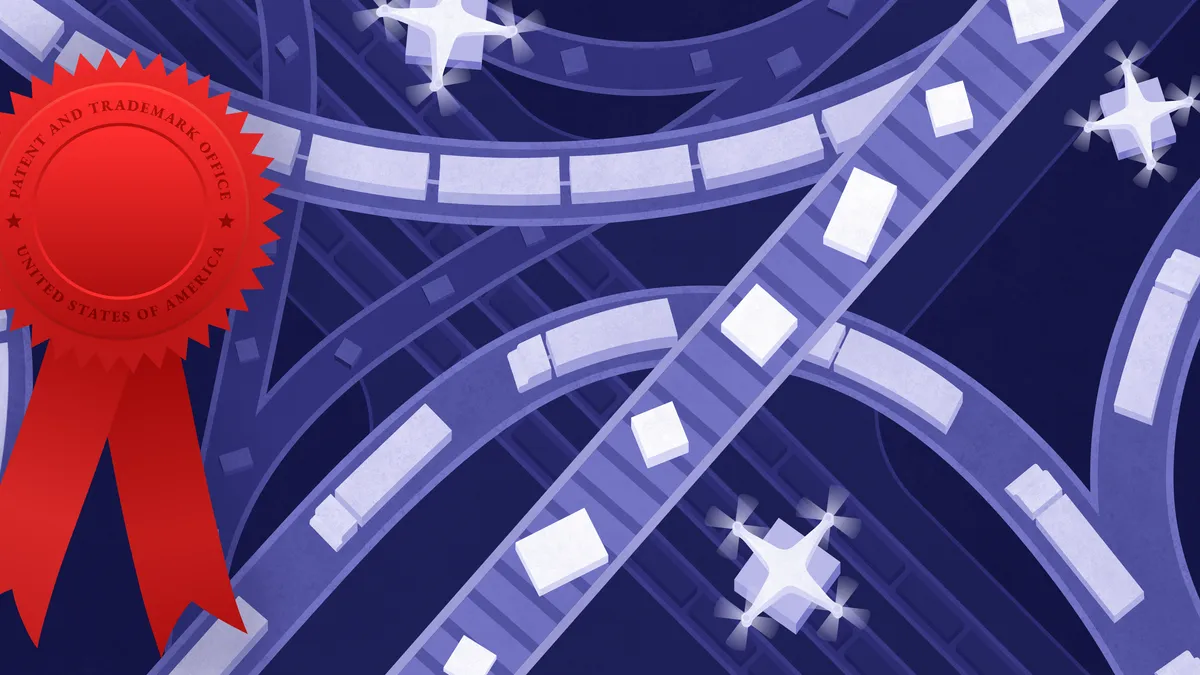This is Patent Pending. Supply chain-related patent applications are published every week and this is where we'll talk about the ones that could have the biggest impact on the supply chain and the ones that challenge the norm. We want to give you an idea of where supply chains are heading and what the industry is thinking. Keep an eye out for this column on Fridays. Read last week's here.
Is that package damaged? Let's order a new one
Many retail locations and apartment complexes have installed locker systems for customers. Oftentimes these existing systems are walls of multiple doors and behind each is a single package. Is that efficient?
In a patent application published this week, Walmart lays out its idea for a locker system, or tower, that uses sensors and a robotic crane to store and retrieve multiple packages, watch them and notice any damage. It could also clean the items if dirty or wet.
- This tower would take a picture of packages when they are deposited.
- It would notice changes to the package, like the shape as a result of it being mishandled.
- If it notices differences then it might use a cleaning mechanism to dry, vacuum or spray the container where the package is stored.
- If this fails to fix the problem, the system could determine the item is no longer fit to sell to a customer and reorder the item.
When someone comes up to get a package they would enter identifying information to start automatic retrieval. The tower could also be set up with sensors that notice a person approaching, allowing it to power off until someone is there to use it.
Read up:
Nike's analytics takes a swing at fulfillment efficiency
Earlier this year, Nike acquired the data science and "demand sensing" firm Celect. Nike COO Eric Sprunk said in a statement at the time that the acquisition "greatly accelerates our digital advantage by adding a platform developed by world-class data scientists."
A patent application filed by Celect before this acquisition, but published for the first time this week, gives insight into the kind of problems the firm might be trying to tackle.
In the patent application, Celect describes a system that can be used for determining where online orders should be fulfilled. One of the examples Celect describes in its patent is a system in which a retailer fulfills orders from a number of customer-facing stores.
- This system would retrieve information on the customer order.
- Automatically break down the order into suborders.
- Use data from the various retail locations, along with delivery information, to determine which store should fulfill the order.
For this final step, the system could take into account the store's staffing, it's forecasted demand and current inventory levels. The delivery address for the order and the store's location could also be a factor. It could look at information for multiple stores throughout the network and determine the best option for the order placed by the customer.
The "hub" where this takes place, shown in the illustration, could be a physical computer or a cloud environment.
The various suborders could be sent to multiple stores. This ensures orders are sent to locations where the items needed are in stock. But some stores might not have real time inventory information because they use sales and inventory systems that need to be updated at the close of business. In this case, the hub can use historical inventory data from each location to forecast what current inventory levels are at each location and make the determination.
Read up:
-
Choosing the right fulfillment option is about weighing cost and speed
-
Ulta plans 'fast fulfillment centers' to handle online orders
-
For a fast supply chain, Target is betting on in-store fulfillment
Seeing into the depths of the trailer
Loading and unloading a truck is largely a manual process, though some are looking for ways to automate the process. One issue, described by Zebra in a patent application published this week, is that two people loading the same truck in different ways results in a varying number of packages making it onto the vehicle. Computer vision could assist human loaders, according to Zebra's application.
- The tool Zebra envisions uses a computer vision system to get measurements of the truck, including depth and width.
- Measurements would be used to create an "occupancy matrix" for the space.
- Information for new packages is retrieved using barcode scans or RFID to provide metadata on the package including weight and dimensions.
- This information is combined with the data on the truck dimensions and can determine the best place for packages to go within this matrix.
Read up:















